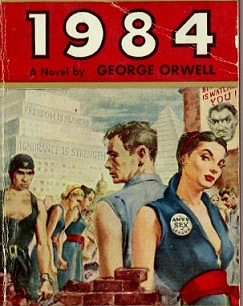Orwell’s 1984 Solution to Criminalize War: “If There was Hope, it must Lie in the Proles”

“The greatest obstacle to discovery is not ignorance – it is the illusion of knowledge.”-Daniel Boorstin
In George Orwell’s 1984 the Outer Party comprised a mere thirteen percent of the population and was subject to the ideological filters in play at the Ministry of Truth and the broader bureaucratic structure. A specific language and way of thinking were closely adhered to. Given their political import, Outer Party members were the most heavily indoctrinated and controlled inhabitants of Oceania. The majority Proles who constituted the remainder of the population was of little consequence so long as their political awareness remained underdeveloped.

While its members withstood more austere conditions, 1984‘s Outer Party is roughly tantamount to those who in our society are the well-informed, college-educated professionals; those whose duty it is to adhere to the ready-made opinion available in the major agenda setting journalistic outlets such as the New York Times, Washington Post, and National Public Radio, where news is carefully selected, crafted, and presented. Such information is then disseminated to the masses via actors in summary capsule form on cable and broadcast television platforms.

Mystified by its own credentials, surrounded by peers who conceive of reality along similar lines, and underscored by the corporate media’s overwhelming tide of disinformation, much of today’s professional class is impervious to “rumors” and “conspiracy theories” that all too often captivate the sordid masses—from unreasonable suspicion over mysterious terrorist attacks to the poorly-informed questions surrounding their leader’s hidden background. Much like the expert officials and agenda setting outlets they look to for prepared interpretations of the world, the opinion leading class’ constituents understand themselves as above all well informed, similarly disinterested and unmoved by groundless passion.
In fact, the programming necessary to attain such a degree of self-assuredness often tends to distance one from reality. For example, revulsion towards war in the United States has historically tended to run strongest among those who have escaped the heavy indoctrination of the professional class—those members of the non-or semi-skilled, working class majority. As historian Howard Zinn observes,
“[I]n surveys of public opinion during the [Vietnam War], it was inevitably shown that people with the highest education—college graduates—were the most supportive of the war. People who had not graduated from high school were the ones most against the war. This is a surprising figure because most people thought the anti-war movement consisted of intellectuals and students and college professors. While those people were most visible in the anti-war movement, public opinion against the war was concentrated in the least educated classes.”
Recent public opinion indicators point to the enduring nature of antiwar sentiment. For example, a recent poll by the Pew Research Center for People and the Press shows that on March 19, 2011, one week before President Obama announced the NATO bombing of Libya, 77% of the US public opposed the destruction of the country’s air defenses. Polling one year later revealed a 62% majority against NATO “bombing Syrian military forces to protect anti-government groups in Syria,” even though almost the same percentage (64%) admitted to having heard “little” or “nothing at all” on “recent political violence in Syria.”
May we thus safely conclude that a majority of the population despite ceaseless propaganda still recognizes how war remains the supreme crime and the greatest demarcation between master and slave? “If there was hope, it must lie in the Proles,” Orwell wrote, “because only there, in those swarming disregarded masses, eighty-five percent of the population of Oceania, could the force to destroy the Party ever be generated.”
James Tracy is Associate Professor of Media Studies at Florida Atlantic University. He blogs at memorygap.org.

